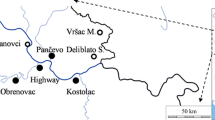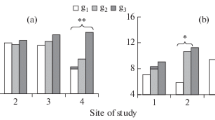Abstract
The prospects for applying the fluctuating asymmetry (FA) of silver birch (Betula pendula Roth) leaves for diagnosis of plant community conditions in technogenically polluted environments are considered with an example of the effect of heavy metals and chronic ionizing radiation. An increase in the minimum sample size to 150–180 leaves and measurements of morphometric traits with an improved accuracy of 0.06–0.07 mm made it possible to overcome the influence of sample size on FA parameters. The excess content of nickel (18.5 times with respect to the background level), lead (16.0 times), manganese (5.8 times), and copper (3.0 times) in birch leaves was accompanied by the increase in multivariate FA index by 20.0%. The chronic exposure to ionizing radiation (at absorbed dose rate on the soil surface of 4.74 µGy/h) elevated the multi-variate FA index of leaves by 29.8% and the content of chlorophylls a and b in leaves by 50.3 and 82.9%, respectively. It was found that the most informative morphometric trait for analysis of birch leaf FA is the distance between the bases of the first and second lateral veins; its FA index rose to 40.4% under the influence of heavy metals and to 53.6% under exposure to chronic ionizing radiation. Thus, FA can be regarded as a sensitive biomarker for detecting early negative responses of forest ecosystems to technogenic pollution.
Similar content being viewed by others
Abbreviations
- ADR:
-
absorbed dose rate
- FA:
-
fluctuating asymmetry
- MAC:
-
maximum allowable concentration
References
MacGleid, Zh., Europe’s environment: the fourth assessment, Evropeiskoe agentstvo po okruzhayushchei srede (EAOC) (European Environment Agency), Kopengagen, 2007.
Ivanov, V.P., Marchenko, S.I., Glazun, I.N., Panicheva, D.M., and Ivanov, Yu.V., The development of female cones and seeds in Pinus sylvestris (Pinaceae) in the emission zone of cement factory (Bryansk region), Rastit. Resur., 2013, vol. 49, pp. 547–557.
Palmer, A.R. and Strobeck, C., Fluctuating asymmetry analyses revisited, Developmental Instability: Causes and Consequences, Polak, M., Ed., Oxford: Oxford University Press, 2003, pp. 279–319.
Graham, J.H., Raz, S., Hel-Or, H., and Nevo, E., Fluctuating asymmetry: methods, theory, and applications, Symmetry, 2010, vol. 2, pp. 466–540.
Shadrina, E.G. and Vol’pert, Ya.L., Developmental instability of the organism as a result of pessimization of environment under anthropogenic transformation of natural landscapes, Russ. J. Dev. Biol., 2014, vol. 45, pp. 117–126.
Zakharov, V.M. and Trofimov, I.E., Homeostatic mechanisms of biological systems: development homeostasis, Russ. J. Dev. Biol., 2014, vol. 45, pp. 105–116.
Lempa, K., Martel, J., Koricheva, J., Haukioja, E., Ossipov, V., Ossipova, S., and Pihlaja, K., Covariation of fluctuating asymmetry, herbivory and chemistry during birch leaf expansion, Oecologia, 2000, vol. 122, pp. 354–360.
Hagen, S.B., Ims, R.A., Yoccoz, N.G., and Sorlibraten, O., Fluctuating asymmetry as an indicator of elevation stress and distribution limits in mountain birch (Betula pubescens), Plant Ecol., 2008, vol. 195, pp. 157–163.
Kozlov, M.V., Zvereva, E.L., and Zverev, V.E., Fluctuating asymmetry of woody plants, Impacts of Point Polluters on Terrestrial Biota: Comparative Analysis of 18 Contaminated Areas, Dordrecht: Springer, 2009, pp. 197–224.
Pulford, I.D. and Watson, C., Phytoremediation of heavy metal-contaminated land by trees — a review, Environ. Int., 2003, vol. 29, pp. 529–540.
Klisaric, N.B., Miljkovic, D., Avramov, S., Zivkovic, U., and Tarasjev, A., Fluctuating asymmetry in Robinia pseudoacacia leaves — possible in situ biomarker? Environ. Sci. Pollut. Res., 2014, vol. 21, pp. 12928–12940.
Nagamitsu, T., Kawahara, T., and Hotta, M., Phenotypic variation and leaf fluctuating asymmetry in isolated populations of an endangered dwarf birch Betula ovalifolia in Hokkaido, Japan, Plant Species Biology, 2004, vol. 19, pp. 13–21.
Beasley, D.A.E., Bonisoli-Alquati, A., and Mousseau, T.A., The use of fluctuating asymmetry as a measure of environmentally induced developmental instability: a meta-analysis, Ecological Indicators, 2013, vol. 30, pp. 218–226.
Wuytack, T., Wuyts, K., Dongen, S.V., Baeten, L., Kardel, F., Verheyen, K., and Samson, R., The effect of air pollution and other environmental stressors on leaf fluctuating asymmetry and specific leaf area of Salix alba L., Environ. Pollut., 2011, vol. 159, pp. 2405–2411.
Betula: Proceedings of the IDS Betula Symposium (Sussex, 2–4 October, 1992), Hunt, D.R., Ed., London: International Dendrology Society, 1993.
Franiel, I. and Wieski, K., Leaf features of silver birch (Betula pendula Roth.). Variability within and between two populations (uncontaminated vs. Pb-contaminated and Zn-contaminated site), Trees, 2005, vol. 19, pp. 81–88.
Ivanov, V.P., Marchenko, S.I., and Ivanov, Yu.V., Features of the organization of biological monitoring in woodlands near-hand plant facilities, Ekologiya i Promyshlennost’ Rossii, 2014, no. 8, pp. 35–39.
Ivanov, V.P., Marchenko, S.I., and Akimenkov, N.V., Ecological state of the natural environment according to the indices of Betula pendula growth stability, Teor. i Prikl. Ekologiya, 2009, no. 1, pp. 28–32.
Geras’kin, S.A. and Volkova, P.Yu., Genetic diversity in Scots pine populations along a radiation exposure gradient, Sci. Total Environ., 2014, vol. 496, pp. 317–327.
Marchenko, S.I., Tekhnika vypolneniya izmeritel’nykh rabot s ispol’zovaniem komp’yutera (Technique of Measuring Works Using a Computer), Bryansk: Bryansk. Gos. Inzhenerno-Tekhnologicheskaya Akademiya, 2008.
Zakharov, V.M., Baranov, A.S., Borisov, V.I., Valetskii, A.V., Kryazheva, N.G., Chistyakova, E.K., and Chubinishvili, A.T., Zdorov’e sredy: metodika otsenki (Environmental Health: Assessment Methodology), Moscow: Tsentr Ekologicheskoi Politiki Rossii, 2000.
Kozlov, M.V., Haukioja, E., Bakhtiarov, A.V., Stroganov, D.N., and Zimina, S.N., Root versus canopy uptake of heavy metals by birch in an industrially polluted area: contrasting behavior of nickel and copper, Environ. Pollut., 2000, vol. 107, pp. 413–420.
Lichtenthaler, H.K., Chlorophylls and carotenoids: pigments of photosynthetic biomembranes, Methods Enzymol., 1987, vol. 148, pp. 350–382.
Otchet o vypolnenii kompleksa nauchno-issledovatel’skikh rabot “Otsenka vliyaniya shlakootvala na lesnye ekosistemy Dumchinskogo lesnichestva v 4–7 kv. Mtsenskogo leskhoza Orlovskoi oblasti” (Report on the Implementation of Complex Scientific Research “Assessing the Impact of Ash Disposal Area on Forest Ecosystems in 4–7 Forest Compartments of Mtsensk. Forestry, Dumchinsk. Forest District, Oryol. oblast”), Orel, Bryansk: Gos. komitet okhrany okruzhayushchei prirodnoi sredy i prirodnykh resursov Orlovskoi obl., Upravlenie lesami Orlovskoi obl., Problemnaya laboratoriya “Bioraznoobrazie i ekologich. monitoring prirodnykh ekosistem” Bryanskoi Gos. Inzhenerno-Tekhnologicheskoi Akademii, 2000.
Valkama, J. and Kozlov, M.V., Impact of climatic factors on the developmental stability of mountain birch growing in a contaminated area, J. Appl. Ecol., 2001, vol. 38, pp. 665–673.
Gorshkova, T.A., Churyukin, R.S., Karaguzova, O.A., Amosova, N.V., Pavlova, N.N., Martirosyan, Yu.M., Vlasova, O.P., and Simakova, I.M., Study of the dependence of fluctuating asymmetry in plants of the size of radioactive contamination, Izv. Vyssh. Uchebn. Zavedenii, Yadernaya Energetika, 2013, no. 1, pp. 116–124.
De Micco, V., Arena, C., Pignalosa, D., and Durante, M., Effects of sparsely and densely ionizing radiation on plants, Radiat. Environ. Biophys., 2011, vol. 50, pp. 1–19.
Pozolotina, V.N., Otdalennye posledstviya deistviya radiatsii na rasteniya (Long-Term Effects of Radiation Action on Plants), Yekaterinburg: Akademkniga, 2003.
Rothwell, G.W., Wyatt, S.E., and Tomescu, A.M.F., Plant evolution at the interface of paleontology and developmental biology: an organism-centered paradigm, Am. J. Bot., 2014, vol. 101, pp. 1–15.
Author information
Authors and Affiliations
Corresponding author
Rights and permissions
About this article
Cite this article
Ivanov, V.P., Ivanov, Y.V., Marchenko, S.I. et al. Application of fluctuating asymmetry indexes of silver birch leaves for diagnostics of plant communities under technogenic pollution. Russ J Plant Physiol 62, 340–348 (2015). https://doi.org/10.1134/S1021443715030085
Received:
Published:
Issue Date:
DOI: https://doi.org/10.1134/S1021443715030085




